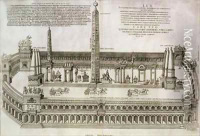Nicolas Beautrizet Paintings
Nicolas Beatrizet, sometimes spelled Beautrizet, was a French engraver of the 16th century, whose life details are not thoroughly documented, leading to uncertainty about his birth year. His activities can be primarily traced through his works, which indicate he was active between the 1540s and his death in 1566. Beatrizet is known to have been born in Lorraine, a region in France, and he moved to Rome, where he spent the majority of his career.
In Rome, Beatrizet became a prominent figure in the field of engraving. He worked for various publishers, including Antonio Salamanca and Lafreri, who were among the leading print publishers of the time. Beatrizet is often remembered for his engravings after famous Renaissance artists, such as Michelangelo, Raphael, and Titian, which helped disseminate their works throughout Europe. His reproductions of Michelangelo's frescoes in the Sistine Chapel are particularly noteworthy for their detail and fidelity to the originals.
Beatrizet's style is characterized by a combination of strong Italian influences and his French heritage, showing a mastery of both line and form. His works encompass a wide range of subjects, including religious themes, portraits, and antiquities, reflecting the diverse interests of the Renaissance clientele. He was also known for his series of prints depicting the wonders of Rome, which served as souvenirs for pilgrims and tourists, as well as records of the city's ancient and contemporary monuments.
Despite his significant contributions to the field of engraving and the dissemination of Renaissance art, Nicolas Beatrizet's work was often overshadowed by other engravers of his time. Still, he remains an important figure in the history of printmaking, with his engravings held in various museum collections and studied for their historical and artistic value. Beatrizet's death in 1566 marked the end of a career that had a lasting impact on the visual culture of his era. Unfortunately, due to the lack of extensive records, much of Beatrizet's life outside of his professional endeavors remains a mystery to art historians.
